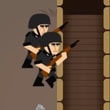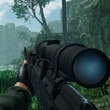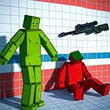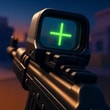🧱🔫 Blocks under siege, nerves of steel
Edge of Defense throws you onto a crenelated wall, hands you a stubborn little pistol, and whispers the most dangerous promise in gaming: “it upgrades.” One click, one pop, one enemy melts into cubes—and then the wave swells again like a tide that forgot manners. The world is chunky and charming, all voxel skies and square trees, but the pressure is real: defend the gate, survive the rush, and squeeze every last gem of power out of a weapon that evolves from toy to thunder. It’s quick to learn, fast to love, and even faster to snowball once your build clicks and the screen starts glittering with shattered pixel critters.
💡⚙️ The gun that grows with you
Your starter sidearm is humble, which is perfect—every upgrade feels like a victory lap. Increase firing speed until the barrel chatters like a sewing machine possessed; add projectiles per shot so your line becomes a fan of doom; sprinkle special effects—pierce, burn, chain—so your bullets keep working after you’ve already aimed at the next target. The joy here isn’t just “bigger number, better.” It’s synergy. A modest fire-rate boost pairs beautifully with a two-way split; a little pierce suddenly turns corridors into bowling alleys; a touch of burn cleans up stragglers while you focus elites. Click by click, you tune a rhythm that matches your fingers.
🌊🛡️ Waves with personality, not just quantity
Every wave arrives with a mood. Early rushes are confident joggers who crumble under focused fire—perfect for banking diamonds and testing your aim. Midgame swaps in shielded brutes that demand pierce or a disciplined burst, plus darting pests that punish tunnel vision. Late waves? Expect mixed packs that coordinate: tanks body-block for glass cannons, speedsters flank while your reticle is busy, and cheeky bombers dare you to overcommit. Reading a wave at a glance becomes your superpower; answering it with the right upgrade turns survival into swagger.
🎯🖱️ Point, click, survive—no homework required
Controls are pure arcade. On PC, aim with the mouse and click to fire; on mobile, tap where you want trouble to end. That’s it. No inventory mazes, no menu math mid-fight. The elegance frees your brain to chase the fun parts: tracking targets, dragging your reticle through a line to exploit pierce, snapping from frontliners to distant snipers the instant their pixel helmets peek over a ridge. It’s the kind of feel that rewards instinct—one more wave, one more clean flick, one more “how did I live through that?”
💎🛍️ Diamonds, drip, and delicious decisions
Finish a wave, bank diamonds, shop smarter. Between assaults, the fortress becomes a cozy upgrade lounge where micro-choices shape macro-runs. Do you jack the fire rate now, or hold for that projectile-split you’ve been eyeing since wave three? Do you commit to burn for area control, or chain lightning to punish clusters? Do you splurge on a skin because style is fuel, or hoard for power because the board just rolled something spicy? Skins don’t boost stats—but they boost swagger, and that counts when the leaderboard is watching.
🔥⚡ Status effects that play nice together (mostly)
Edge of Defense keeps effects readable and fun. Burn stacks softly and tidies the lane behind your shots; chain arcs sideways to slap buddies who thought they were safe; slow turns elites into polite targets; pierce does what pierce does—straight lines, straight problems solved. The trick is choosing one primary and one backup so your fragments sing the same song. Burn + pierce is a lane mower. Chain + split is crowd control theater. Slow + high fire rate is bullying disguised as strategy.
🧭🏰 The fortress as a friendly puzzle
Your wall isn’t just a stand-and-shoot platform; it’s a map with angles. Corners let you farm pierce value by drawing bead down the centerline. Elevated parapets create arcs where split projectiles fan across entire packs. Gaps in the crenels reveal cheeky sightlines—thread a shot and watch three enemies pop like bubble wrap. Positioning equals power: step left to align a column, step right to protect the gate from flankers, step back to buy a microsecond of breathing room before the next click.
📈🏆 Leaderboard hunger done right
The scoreboard isn’t a scold; it’s a dare. Survive longer, clear faster, finish waves with overkill efficiency and watch your rank tick up in those tiny, addictive increments. The best runs feel like a conversation between your build and the spawn logic—you solve a wave cleanly, the game nods, spawns nastier, and you grin because your next upgrade was made for exactly this. Screenshot-worthy moments happen often: a perfect chain volley that erases a flank, a last-second pierce line that saves the gate at 1 HP, a burn trail that writes your name in orange across the field.
🧠💡 Micro-habits that turn “good” into “why won’t they die?”
Lead runners, not packs—killing the front halves the incoming DPS. Stutter-tap the trigger to sync your volleys with split cone timings. Sweep through enemies instead of hard-stopping on one; pierce and burn both appreciate generosity. When shielded brutes march, aim at the second row so the first dies to collateral. If a wave mixes sprinters and heavies, delete the sprinters first; your fortress cares about time-to-contact, not drama. And always buy one “brain upgrade” that serves as insurance—slow radius or small heal—so you can stay aggressive without gambling the whole run.
🧱🎨 Cozy blockcraft vibes, combat-grade clarity
The art leans Minecraft-cute—chunky mobs, friendly colors, skies that look poured from milk—but readability stays razor sharp. Hit flashes sparkle without blinding, crit pops sound like tiny fireworks, and effect icons tell the truth at a glance. When burn is working, you see it simmer. When chain procs, you hear that zippy crackle across the lane. The whole mix is tuned for flow: enough feedback to feel powerful, not so much that your eyes get tired.
⚙️🔁 Runs that respect your time
A session can be five minutes or fifty. Early exits still pay diamonds; deep pushes unlock new modifiers and enemy patterns that make the next run smarter by default. The cadence is delightful: fight, shop, grin, repeat. Failures aren’t brick walls—they’re blueprints. “Should’ve bought pierce two waves earlier.” “Next time, skip split until chain drops.” “Okay, burn was cute; slow is love.” You’ll talk to yourself, then prove yourself right in ten minutes.
🎮📱 Play anywhere, feel the same power
Mouse + click has that PC-arcade purity; aim is crisp and micro-adjustments are buttery. On touch, the reticle snaps with zero fuss—tap, track, tap—and the game helps without babysitting, letting you pull off split-cone sweeps with thumb-level precision. Either way, the fortress holds, the gun sings, and the scoreboard gets ideas.
🌪️🧩 Challenge spice for seasoned defenders
Chase self-imposed goals: no-miss waves for bonus diamonds, “pierce-only” builds that turn lanes into math problems, “slow & burn” control runs where nothing reaches the gate because physics refuses. Practice kiting boss-packs around a central column to farm chain value; master the art of “pre-aim”—placing your reticle exactly where the next spawn will step. Edge of Defense has the kind of depth that hides inside simplicity and keeps rewarding attention.
🏁✨ The wave you’ll remember
Gate at a sliver, hands a little shaky, shop timer counting down. You gamble on split instead of raw damage and step to the far right crenel. The horn blares, a river of cubes pours in, and your first volley turns into a green fan that carves the lane so clean you actually laugh. Chain procs across the backline, burn finishes the rest, and the leaderboard coughs up a rank you didn’t dare expect. You didn’t just survive—you solved the wave like a riddle.
💙 Why it belongs on Kiz10
Instant pick-up, satisfying upgrades, pixel-charm atmosphere, and a leaderboard that turns “one more wave” into “where did my evening go?” Edge of Defense is built for Kiz10’s sweet spot: quick sessions with real depth, clean controls, and endless reasons to try a different build. Defend the wall, tune the pistol, and watch those cubes fly.
 AIM polygon
AIM polygon












































